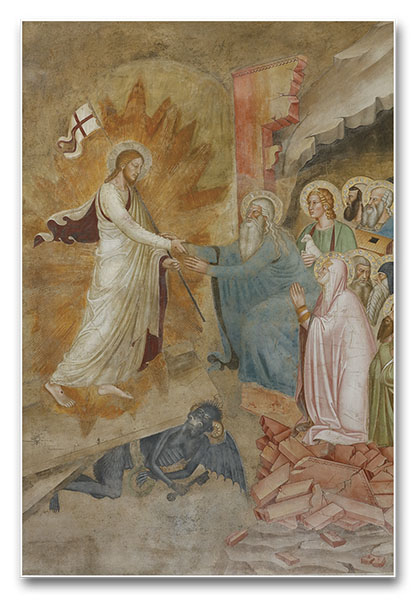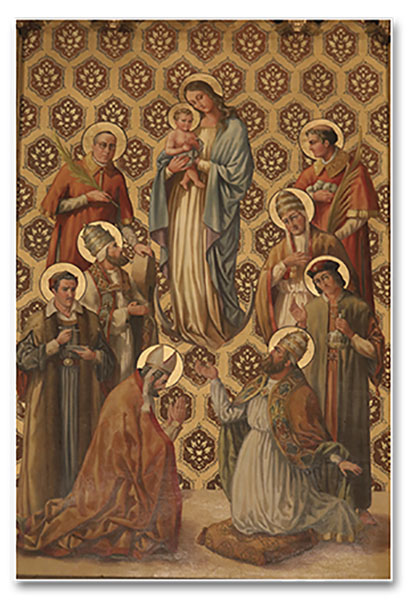Throughout history, there are moments when God’s mercy shines forth with a mildness that enchants us; at other times, however, He unleashes His majestic wrath… What is the reason for this alternation?
When, on a fine day, we enter certain forests where the canopy is not very dense, both shadows and light are visible on the ground.
Here and there, a shaft of light that has managed to make its way through the foliage intensely illuminates a stone, a bug or a dry leaf, which becomes beautiful because of the beam of light that is cast upon it. Amidst the archipelago of bright spots, however, a lacework of shadows is formed, sometimes so thick that it creates the appearance of the dead of night even at midday. The sun is at its peak, but the leaves prevent its rays from entering.
On the forest floor, something colourful appears and we sense that there is some order, some meaning, some reason for it. But without looking up, we cannot discover what it is.
So it is with history. Whoever is not acquainted with the branches above will never be able to explain the designs below.
Alternation between chastisement and kindness
In analysing God’s action in history, we note that there are magnificent alternations between mercy and holy wrath, and both captivate us. What is the reason for this alternation? Can we grasp the perspective from which anger and indignation are meted out, or ascertain whether they or mercy are approaching?
In this vale of tears, a haunting question may arise at the apex of mercy: “How long will it last? How long will this goodness accompany my steps, tolerating my infidelities?”
And, at the apex of a trial, a question full of hope may emerge: “How long will this trial last? Will not the day of mercy soon come? Who knows whether, upon turning a corner, flipping the page of a book, praying the next rosary bead, or in receiving today’s Communion, the hour of mercy may not arrive…”
Sometimes mercy comes without an appointed time: we did not perceive it approaching, and suddenly we are inundated with it. And then we are enveloped with consolation.
How can we detect the main thread of the plot, so as not to be caught in the mesh of justice and remain in that of mercy? How to unravel it with our merely mortal human eyes?
Caressed by God in the cool of the day
The key to solving the mystery lies in something deeper. Let us picture the beauties that God has placed in terrestrial Paradise. We can imagine how nature in Paradise was at once intoxicating, upright, and capable of stirring and uplifting all innocence to its summit.
There was also man’s inner paradise. As he strolled through Eden, his innocent soul entered into communication with all that was holy, good, true and beautiful.
In the cool of the day, God would come to converse with Adam. As far as our human intelligence, limited by original sin, can tell, either He manifested himself directly to Adam – but supporting him, an insignificant creature in the hands of the Creator, lest he should faint away – or rather, without showing himself, He helped him to consider all things: some little ruby scattered on the ground, a golden bird, an eagle which seemed to be made of enamel, a humming-bird more delicate and more delightful than all the humming-birds on earth.
As Adam beheld everything, spellbound, the Creator would whisper in his ear: “This being explains Me in such a way, and that one in another.” And God, whose knowledge is infinite, penetrated to the depth of his soul, saw his reactions, loved them and produced them, one after the other, with the pleasure of an artist who polishes a stone as he creates a jewel. The Most High thus formed the mentality of Adam, the first man, in whom the whole human race was contained. We can well imagine God’s tenderness towards him.
There was, however, an arcane moment when the admirable took on a different hue and went from luminous to mysterious. And God, if such could be said of Him, turned away from His masterpiece, distanced himself and left Adam alone.
The Creator gives way to the Judge

Then the Creator allowed the devil, that unclean, leprous, execrable and vile being, to enter Paradise, disguised as a serpent, and to tempt Adam and Eve.
At the moment of temptation, it is certain that God continued to help them and even provided them with generous protection, but not so great as to prevent them from sinning. To use an image suited to our earth, He gave them all the “antivenoms” but allowed the “venomous animal” to bite them.
At that instant, one could say that the caress ceased and the Judge entered the scene. Suddenly an infinite distance can be felt between God and the two; the drama begins to unfold.
Until the day before, the Creator took Adam’s soul in the cool of the day, and, so to speak, kissed and encouraged it. But now, He regards it without manifesting delight; He is judging: “Who is this, and how can he contravene Me? The time has come to call him to account for all that I have given him.”
Mercy, without disappearing from the scene or ceasing to have an influence, was set to one side. On the other side, fury begins to arm itself in the form of a single question: “What will become of this man?”
Mercy is condensed into justice
To the extent that man gives in, all the mercy dispensed to him rises up before God and cries out for justice: “I gave, I did, I taught, I explained, I treated kindly, on such and such a day. Now I want to know what profit you drew from it. Come into my presence and take action. The moment has come for you to pay back what you have received. Moreover, for the great quantity I have given you, I charge you little; but the little I charge you has this condition: I want all that I am charging!”

Igreja de Santa Maria Novella, Florença (Itália)
At a certain point, mercy is condensed into justice. And God, because He was merciful beyond justice, becomes just without mercy: “Now I will pass sentence!”
The accumulated wrath is unleashed at the moment when the first man consummates the sin. He is like one gone mad, but he is in fact fully responsible. Adam, who used to converse with God, was tempted and listened to the devil. Judgement has arrived! Once the fault has been committed, justice does not delay for an instant! One could almost say that as sin fills Adam, justice enters him.
And he begins to feel troubled, insecure, uneasy; Eve also. Both are broken, shattered! And sin spreads like a shadow over all who will descend from them, that is, over the human race until the end of time!
Everything is stricken with such terrible wrath that God the Father – whose plan, some theologians affirm, was that the Word would become incarnate for the joy of human nature and the glory of creation, irrespective of sin – subjects His own Son to the torment of the Passion and Death on the Cross, to make reparation for that sin.
God asks His Son to shed all of His Blood
After this followed millennia and millennia of mercy interspersed with manifestations of justice. It suffices to think of these two great acts of justice: the expulsion of Adam and Eve from Paradise and the demand for the Blood of Christ to redeem mankind.
One drop of the infinitely precious Blood of Our Lord would be enough to redeem mankind. But the Father wanted Jesus to pour it all out, so that when there only remained a mixture of water and blood in His sacred Body, the centurion Longinus came and pierced Him with a lance, immediately reaching His Heart, the symbol of love. That is how far the blow dealt by men goes! And a kind of lymph yet issues forth, which is the last redeeming drop.
One might say: “Finally, everything has been paid!” It had the merit to be; the Circumcision would have already been enough. If the Child Jesus had wounded himself in a rose bush, with a drop of His Precious Blood the human race would have been redeemed and God’s anger appeased. But He wanted more.
Although the Redemption wrought by Our Lord Jesus Christ has infinite merit, God willed that there should be a redemptrix of trust: Our Lady, who was immaculate, trustingly suffered all the sorrows and all the torments, to help redeem the human race. But there is yet more. In the Mass, the sacrifice of the Cross is renewed for already redeemed humanity, and so it will continue until the end of the world.
Faced with these considerations, we could ask: how great is the divine wrath? We are left speechless… But we might also add: how great is His mercy? For, in reality, God maintains His plan. He subjects all men to original sin, but He exempts Our Lady from it to be able to save them. We see how mercy stretches beyond our field of vision, and so does justice.
Our understanding is stunned when it beholds mercy, and the same happens when it considers justice. We exclaim, “But, Lord, such great mercy!” And then immediately afterwards: “But, Lord, so much justice!” It is because we are very small. We should instead say, “Lord, how infinite Thou art in Thy mercy and infinite in Thy justice!”
God’s mercy towards Adam and Eve
Adam and Eve come to earth and then the history of man begins. There is the episode of the fratricide of Abel by Cain and all the rest. Eve sees her son killed by another son. She, who did not yet know death, came face to face with it in her beloved son.

Catedral de Santa Maria da Assunção, Barbastro (Espanha)
Then comes the stunning mercy! They die in a state of holiness, with heroic virtue. They can be called St. Adam and St. Eve! But they will wait in limbo for about five thousand years, until the Saviour comes. To wait five days… how terrible! Sometimes waiting five minutes is intolerable. Can we imagine what five thousand years of waiting means?
Finally, a trembling runs through limbo, everyone senses that the Saviour is coming. Even before the Resurrection, the most holy Soul of Our Lord Jesus Christ enters there. And once again they contemplate death: “And so the Saviour is subject to the law of death…” He appears radiant and explains: “I had to die to save you.”
In this way, we perceive the swells of justice and the swells of mercy in the open sea of God’s designs. We have no idea of the violence, so to speak, of these alternatives. We can imagine Adam and Eve, who knew they had been forgiven, crying out heart-wrenchingly: “To that point… To that point…”
Jesus resurrects! And when the Redeemer ascends to Heaven, He takes them with Him. Entering the heavenly mansion to enjoy eternal happiness, Adam and Eve are venerated even by the Angels: “These are the parents of the human race, the ancestors of Our Lord!”
All this began in terrestrial Paradise, with the entry of the serpent. We thus understand the vastness of the panorama, and how God is greater than us.
At the time of chastisement, not rejecting Our Lady will suffice
And what about Our Lady?
With Her comes for us the lumen of hope. Maternal love is the most tangible symbol of God’s love, even more than paternal love.
As long as the child does not reject his mother completely, does not produce one of those ruptures which banish all hope, the mother conserves every form of parti pris for her child. Even if we have – alas! – committed infidelities, thanks to Our Lady we have not produced a rupture with Her. Mary Most Holy has the utmost partiality for us; She will make every arrangement, extend every kindness and find ingenious solutions. Thus we can hope.
Woe to those who break with Her! For the punishment will be worse than that deserved for breaking with the Father. Scripture says: “For a father’s blessing strengthens the houses of the children, but a mother’s curse uproots their foundations” (Sir 3:9). ◊
Taken, with adaptations, from: Dr. Plinio.
São Paulo. Year XIV. N.154 (Jan., 2011); p.24-27







